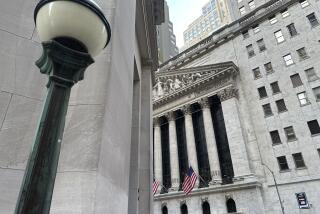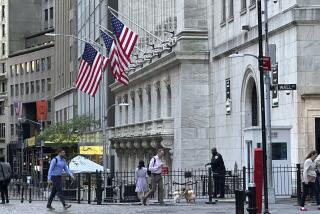Soaring Yields Hit Shorter-Term Bonds
- Share via
The pain in the bond market is spreading to investors who may have thought they were protected from rising interest rates.
Returns on shorter-term securities -- and the mutual funds that invest in them -- are beginning to slide into the red as rates continue their startling turnaround.
The latest blow came Tuesday, when the U.S. Treasury’s sale of new three-year notes was poorly received. That news, combined with fresh data pointing to a stronger economy, triggered another dive in bond prices that sent yields soaring.
The rise in shorter-term Treasury yields was particularly dramatic: The two-year T-note, for example, jumped to 1.82%, up from 1.68% on Monday and a seven-month high.
By contrast, the 10-year T-note yield rose to 4.39%, up from 4.28% on Monday but below the one-year closing high of 4.44% reached one week ago.
Much of the focus on the turnaround in bond yields, and drop in bond prices, since mid-June has been on longer-term securities, such as the 10-year T-note.
Many individual investors, however, have shied away from longer-term bonds in recent years, instead favoring less-volatile shorter-term bonds and mutual funds that target those issues.
That has been a smart move: The returns from shorter-term bond sectors have been decent and steady over the last few years, providing a haven from the stock market’s losses.
But the continuing surge in market yields means many owners of shorter-term bonds may be in danger of seeing their securities dip into the red year for the year in terms of “total return” -- interest earnings plus or minus principal change.
Intermediate-term government bond mutual funds, which own securities maturing in three to 10 years, already are down for the year, according to fund tracker Lipper Inc. in Denver. The funds had a negative total return of 0.7%, on average, through July.
The average short-term government bond fund was clinging to a 0.3% positive total return for the year, through July. Short-term funds own securities maturing in one to three years.
The poor returns this year are a big change from the last three years, as market interest rates mostly declined, boosting the value of older bonds.
The average intermediate-term government bond fund produced a total return of 7.2% a year in the three years ended July 31, according to Lipper.
Financial advisors worry that risk-averse investors have come to believe they can’t lose money in short- and intermediate-term bonds -- and that some will panic and sell as their recent losses become apparent.
That could be a big mistake, depending on why an investor bought bonds in the first place, said Andrew Clark, fixed-income analyst at Lipper.
He noted that shorter-term bonds and funds still pose less risk of loss than longer-term bonds. As market interest rates rise, long-term fixed-income securities are devalued at a faster rate than shorter-term issues.
Through July, the average year-to-date total return on long-term government bond funds was a negative 1.7%, more than twice the loss of intermediate-term funds.
The type of bonds owned by a fund also will determine how much its principal value declines as rates rise. So-called investment-grade funds, which often own a mix of government bonds and high-quality corporate issues, still were positive for the year to date through July, Lipper data show.
Clark said it’s important for bond owners to remember that, under most scenarios for interest rates, “A big loss on bonds still is just a single digit” in any given year.
By contrast, some investors lost 90% or more in technology stocks during the bear market.
Even so, many advisors are preparing clients for more bad news about bonds.
The upward pressure on market yields since mid-June has stemmed in large part from expectations that the economy is accelerating.
There was more evidence of that on Tuesday: The Institute for Supply Management said its index of activity in the services sector of the economy jumped to 65.1 in July, the strongest reading since 1997.
Bond yields also have been pushed up as speculators have sold securities after betting in spring -- incorrectly -- that the Federal Reserve might begin to buy long-term bonds to help inject money into the economy.
The ballooning federal budget deficit also has hurt the bond market as investors face an onslaught of Treasury borrowing.
Tuesday, the sale of $24 billion in three-year T-notes met with weak demand and required the government to pay a yield of 2.42%, well above expectations.
“The auction was a disaster,” said Ralph Axel, U.S. government bond strategist at HSBC Securities USA in New York.
Analysts said a key reason shorter-term bond yields have been rising rapidly over the last week is that more investors are giving up on the idea that the Fed would continue to hold its benchmark short-term rate at 1% well into 2004.
That belief had been expected to “anchor” yields on shorter-term securities, even if longer-term yields surged.
Now, more investors are losing faith that the Fed can hold off tightening credit beyond the first quarter of 2004, if the economy continues to revive, Axel said.
If the Fed does begin to raise its benchmark rate, investors could begin to flee bonds in a panic “worse than the latest sell-off,” said Bill Hornbarger, fixed-income strategist at brokerage A.G. Edwards in St. Louis.
Individual investors who have a bullish outlook on the economy, he said, should think about why they own bonds and make decisions accordingly.
If bonds are needed for income, then investors shouldn’t feel compelled to sell, he said. Interest will continue to be earned, even if bonds’ prices decline.
“But if you bought bonds just to get out of stocks during the bear market, then you may have to think about doing something else with your money,” Hornbarger said, if the thought of losing any principal value in bonds is too much to bear.
*
(BEGIN TEXT OF INFOBOX)
Income fund returns, by category
Here are average total returns (interest earnings plus or minus principal change) for key categories of fixed-income funds.
*--* Annualized Total return: Total return: total return Category July YTD* (last 3 years)* Money market +0.03% +0.3% +2.4% Short-term govt -0.75% +0.3% +5.5% Short-term investment -0.97% +1.2% +5.7% grade Junk corporate -0.99% +13.5% +2.0% Intermed.-term govt -2.97% -0.7% +7.2% Intermed.-term inv. -3.23% +0.9% +7.5% grade Long-term high-grade -3.60% +1.0% +7.4% corp Long-term lower-grade -3.64% +3.0% +7.6% corp Long-term govt -4.00% -1.7% +7.0%
*--*
* Through July 31
Source: Lipper Inc.
More to Read
Inside the business of entertainment
The Wide Shot brings you news, analysis and insights on everything from streaming wars to production — and what it all means for the future.
You may occasionally receive promotional content from the Los Angeles Times.










